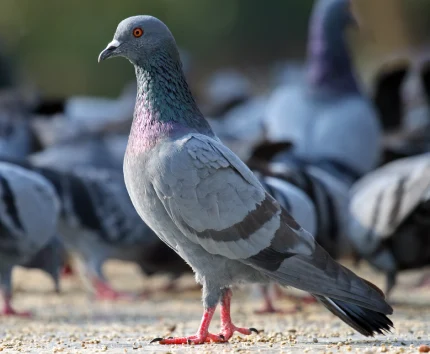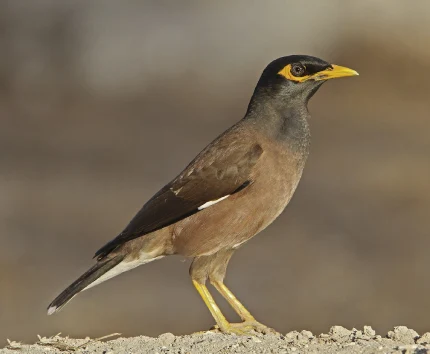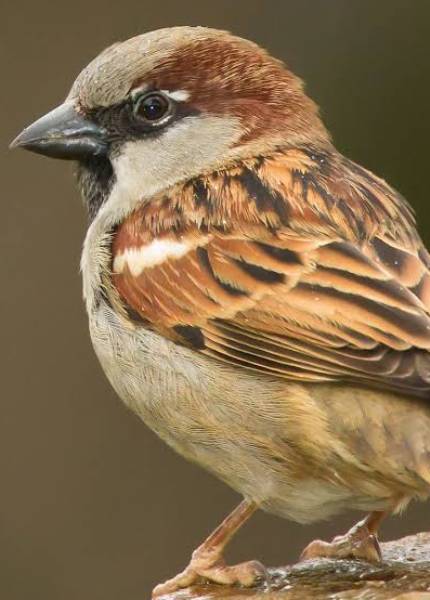Bird Control
Biology and Behaviour of Urban Birds
- Feral Pigeon ( Columba livia )
- Common Myna ( Acredotheres tristis )
- House Sparrow ( Passer domesticus )
Feral Pigeon ( Columba livia )
Feral Pigeon ( Columba livia )
Key Facts
- Common pigeons (Columba livia) are grey with a whitish rump, have two black bars on secondary wing feathers, and have a broad black band on the tail. Generally have red feet.
- Domestic and feral birds exhibit grey, white, tan, and blackish varieties. Pigeons glide with wings raised at an angle.
- On Average, they are 250 – 350 Gms in weight and 31 – 34 centimetres in length.
- Generally have red feet.
- Pigeons are commonly found around farm yards, parks, on city buildings. They nest and roost on building ledges, eaves, steeples, and vents, etc.
- Food Habits : Pigeons are primarily grain and seed eaters, but they will feed on garbage, livestock manure, insects and other foods when their preferred foods become scarce.



- General Biology : Nests typically consist of sticks, twigs and grasses clumped together to form a crude platform. Pigeons are monogamous. Eight to 12 days after mating, the females lay 1 or 2 white eggs which hatch after 18 days. The male cares for and guards the female and nest. The 72 squabs (young) are fed a secreted substance called pigeon milk. When mature, at 4 to 6 weeks, the young leave the nest. Breeding may occur in all seasons, but peak reproduction occurs in the spring and fall. Pigeons commonly live for 15 years, however, in urban populations, it is estimated that few pigeons live for more than 3 or 4 years.
- Pigeons commonly live for 15 years, however, in urban populations, it is estimated that few pigeons live for more than 3 or 4 years.
Common Myna ( Acredotheres tristis )
Key Facts
- The Common Myna is readily identified by the brown body, black hooded head and the bare yellow patch behind the eye. The bill and legs are bright yellow. There is a white patch on the outer primaries and the wing lining on the underside is white. The Common Myna thrives in urban and suburban environments. The Common Myna is pre-adapted to habitats with tall vertical structures and little to no vegetative ground cover.
- The Common Myna is a nuisance to city buildings; its nests block gutters and drainpipes, causing water damage to building exteriors.
- Creating much Fouling and Deafening noise.
- Feed on almost anything, insects, scraps, fruits, vegetable.
- For Nest building they are using Leaves, Grass and Rubbish material. Roof voids, trees and other similar locations are ideal for nests.



House Sparrow ( Passer Domestics )
Key Facts
- Male: grey crown, black throat, greyish-white cheeks. Females and young are more dull brown.
- The House Sparrow is a chunky bird, ranging from 14 to 18 centimetres.
- It has a large rounded head, a short tail, and a stout bill. In weight, the House Sparrow generally ranges from 24 to 39.5 grams.
- Weight varies by sex, with females usually smaller than males. Younger birds are smaller, males are larger during the winter, and females are larger during the breeding season.
- The House Sparrow is a very social bird. It is gregarious at all seasons when feeding, often forming flocks with other types of birds. It also roosts communally, its nests are usually placed together in clumps, and it engages in a number of social activities, such as dust and water bathing, and "social singing", in which birds call together in bushes. The House Sparrow feeds mostly on the ground, but it flocks in trees and bushes.
- Habitat : Closely associated with permanent human habitations, including farmyards, villages, parks, suburban areas and city centres.



Damages
- House Sparrows are often a nuisance in urban areas like manufacturing and food processing plants.
- Gutters and drainage pipes clogged with sparrow nests can back up and cause extensive water damage and fires have been attributed to electrical shorts caused by machinery housing sparrow nests.
- Faeces buildup can lead to structural damage from the uric acid in droppings, plus the bacteria, fungal agents and parasites in the faeces also pose a health risk.
- In grain storage facilities, faecal contamination probably results in as much monetary loss as the actual consumption of grain.
- House sparrow droppings and feathers create janitorial problems as well as hazardous, unsanitary, and odoriferous situations inside and outside of buildings and sidewalks under roosting areas. Damage can also be caused by the pecking of rigid foam insulation inside buildings.
- The chattering of the flock on a roost is an annoyance to nearby human residents. Damage Identification (Why is a pigeon considered a pest?
Damage Identification (Why Pigeon is a considered as a Pest?)
Under some circumstances, some urban bird species (especially pigeons, doves, gulls, house sparrows, starlings, blackbirds, grackles and corvids) that congregate at too high population densities produce droppings that harm such human artefacts as historical monuments, buildings, statues, fountains and cars. Also, certain synanthropic avian species can be extremely noisy at feeding sites, breeding colonies, and communal roosts. Moreover, some of them can be harmful to urban vegetation (trees and such fruits as cherries) in gardens (blackbirds and starlings, for example) or cause additional pollution problems with their droppings, which foul yards, sidewalks (creating the risk of slipping and physical injury for pedestrians) and roads, and also produce foul odours. In so doing, such species as pigeons, gulls, starlings, grackles, blackbirds and corvids become a nuisance. In addition, some medium-sized gregarious birds, such as gulls, rooks and lapwings, can cause dangerous aircraft accidents, during take-off and landing at suburban airfields.
- Pigeons also carry and spread diseases to people through their droppings. They are known to carry or transmit pigeon ornithosis, encephalitis, salmonella food poisoning, and several other diseases.
- Dusty pigeon manure may also harbor airborne spores of the causal agent of histoplasmosis, a systemic fungus disease that infects people. Common ectoparasites of pigeons include various species of mites, fleas, ticks, and bugs, many of which will readily bite people.
- Pigeons can be a threat to human safety around airports. Pigeons are considered a “medium priority hazard”.
- Pigeon droppings deface and accelerate the deterioration of buildings, thus increasing the cost of maintenance.
- Large amounts of droppings can kill vegetation and produce an objectionable odour. Pigeon manure deposited on park benches, statues, cars, and unwary pedestrians is aesthetically displeasing.
- Around grain handling facilities, pigeons consume and contaminate large quantities of food destined for human or livestock consumption.
- A source of ectoparasites. In urban areas, nests of feral pigeons in the lofts of houses can result in invasions of soft ticks (such as the pigeon tick, Argas reflexus) into closely situated flats and apartments. Such invasions can result in infestations of their occupants, often leading to allergic reactions. Other pigeon ectoparasites can occasionally attack humans as well. Examples of these are mites, such as the chicken mite (Dermanyssus gallinae), which may produce allergic reactions, especially in children and susceptible adults; bugs, such as the pigeon bug (Cimex columbarius); and fleas, such as the pigeon flea (Ceratophyllus columbae).
Health risks are often exaggerated. Nevertheless, large populations of roosting birds may present risks of disease to people nearby. The most serious health risks are from disease organisms growing in accumulations of bird droppings, feathers and debris under a roost. If conditions are right, particularly if roosts have been active for years, disease organisms can grow in these rich nutrients. When parasite-infested birds leave roosts or nests to invade buildings, their parasites can bite, irritate or infest people. To be safe, when investigating or cleaning up these areas, wear a disposable mask and protective clothing, including safety glasses, plastic or rubber gloves, coveralls and a cap.
Histoplasmosis
This systemic fungal disease is transmitted to humans by airborne spores from soil contaminated by pigeon and starling droppings, as well as droppings by other birds and bats. The soil under a roost usually has to have been enriched by droppings for three or more years for the disease organism (Histoplasma capsulatum) to increase to significant levels.
Most infections are mild and produce either no symptoms or a minor flu-like illness. The disease can, on occasion, lead to high fever, blood abnormalities, pneumonia and even death. A potentially blinding eye condition, called ocular histoplasmosis syndrome, can result from infection by the disease organism. The central part of the retina becomes inflamed and is damaged as blood vessels grow inside the affected area. An estimated 100,000 people have the rapidly progressive form that can lead to blindness.
Cryptococcosis
This fungus is typically found in accumulations of pigeon droppings in attics, cupolas, ledges, water towers and other roosting and nesting sites. Even when old and dry, bird droppings can be a significant source of infection. Cryptococcosis has been found in as many as 84 percent of samples taken from old roosts. The disease, acquired by inhaling yeast-like vegetative cells, results in two forms. The cutaneous form is characterized by acne-like skin eruptions or ulcers just under the skin. The generalized form begins with a lung infection and spreads to other areas of the body, particularly the central nervous system, and can be fatal.
Ecto parasites
Birds can harbor external parasites that can invade buildings. A long list of mites infest pigeons, but the northern fowl mite and chicken mite are usually the main culprits. Other pigeon ecto parasites that may cause problems inside buildings are the pigeon nest bug (a type of bedbug), various species of biting lice, the pigeon tick and the pigeon fly. Droppings, feathers, food and dead birds under a roosting or loafing area can cause an environment for the ecto parasites to survive.
Bird Netting Services
Elevate your property’s aesthetics while protecting it from avian intruders with Truly Nolen’s Bird Netting Services. Crafted from durable HDPE with UV resistance, our bird control nets offer long-lasting defence. They are virtually invisible and aesthetically pleasing, they blend seamlessly with your surroundings. Specifically designed for pigeon control, our nets feature a 50mm x 50mm square gap and come in a crisp white color. Enjoy peace of mind with a generous 3-year warranty, ensuring lasting protection for your space.
Our Clients













Truly is present in more than 37 cities across the country, having more than 400 employees. TPS is currently serving 4000+ commercial and 10000+ residential clients, with an increasing list of clients on a daily basis.
- 915, Hemkunt Tower, 98 Nehru Place, New Delhi -110019.
© Truly Nolen 2023 . All Right Reserved. Designed By Verve Media.
